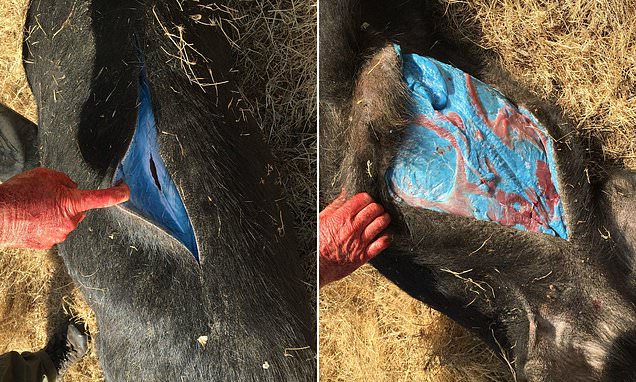Hunters and wildlife enthusiasts in California have stumbled upon a bizarre and unsettling phenomenon—wild pigs with bright, almost glowing blue fat and flesh.
The unusual sight has spread confusion and concern across the region, leaving many asking what could possibly be behind such a shocking change in the animals.
According to locals, the strange findings have been happening more frequently in recent months, with hunters reporting the animals’ flesh looking like it had been dyed with neon paint.
Some described the hue as “blueberry blue,” making it impossible to ignore.
Officials Issue Health Warnings
Authorities were quick to respond with a clear warning: do not eat the meat from these animals.
Experts suspect the blue pigmentation is not a natural mutation but the result of toxic exposure.
Tests point toward diphacinone, a rodent poison dyed in bright colors so it can be easily recognized when used on farms and ranches.
Officials fear that the contamination isn’t limited to wild pigs.
Other wildlife—such as deer, geese, and even bears—could also be at risk if they ingest poisoned bait or prey on affected rodents.
How the Poison Works
Diphacinone is an anticoagulant rodenticide.
It kills by preventing blood from clotting, eventually causing internal bleeding.
What makes it especially dangerous is that once an animal eats the bait—or even eats another poisoned animal—the toxins linger in the tissues for a long time.
That means if a human or predator consumes the contaminated meat, they could become sick even if the meat has been cooked.
Symptoms include lethargy and, with repeated exposure, far more serious health issues.
A Repeated Problem in California
This isn’t the first time hunters have come across the strange blue fat in pigs.
Back in 2015, photos surfaced showing fluorescent blue tissue in a wild pig from Morgan Hill, California.
At the time, no one was sure of the cause, but it now seems likely that rodenticide poisoning was behind it.
Further studies have supported this suspicion.
Research conducted in 2018 found that around 8.3 percent of wild pigs tested in the state carried residues of anticoagulant rodenticides.
To counter the growing threat, California introduced tighter restrictions on the use of diphacinone in 2024.
What Hunters Should Do Now
Wildlife officials are urging hunters to be cautious and vigilant.
Any animals with blue-tinted fat or flesh should not be consumed, and sightings should be immediately reported.
Since the chemical doesn’t always leave visible traces, hunters are advised to take extra care when preparing game meat.
As Ryan Bourbour from the California Department of Fish and Wildlife explained, rodenticide exposure is especially worrying when the substances are used near natural habitats.
Even non-target species are at risk of poisoning, creating a ripple effect that spreads through the ecosystem.
The Bigger Picture
The discovery highlights a larger issue—how the use of pest control chemicals can end up harming far more than their intended targets.
While diphacinone is effective against rodents, its side effects are spilling over into wildlife populations and potentially into the food chain.
Experts stress that more needs to be done to balance pest management with environmental protection, as the fallout from these substances threatens not just animals but humans too.
What’s Next?
Authorities are expected to continue monitoring the situation and tightening restrictions on rodenticide use where wildlife is present.
Hunters, meanwhile, are being encouraged to remain alert, avoid consuming any suspicious game, and spread awareness of the risks.
For now, one unsettling fact remains clear: the sight of a wild pig with glowing blue flesh is not just strange—it’s a warning sign of a much deeper environmental problem.



